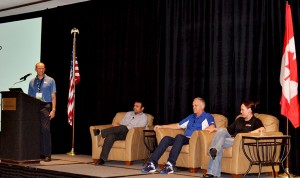In spite of 90-degree temperatures, snow removal became a focal point in Columbus, Ohio, this week when the Snow & Ice Management Association’s (SIMA’s) Snow & Ice Symposium came to town.
The 17th annual event is being held June 18 to 21 at the Greater Columbus Convention Center.
And with, as some call it, “the winter from hell” still haunting the minds of many attendees, SIMA CEO Martin Tirado moderated a panel discussion on the state of industry during the general member meeting the first evening of the event.
The panel comprised:
- Mike Anderson, SIMA board chair and president of Snow & Ice Pros, Highland, Ind.;
- Laura Ingram, director of operations at Ingram Enterprises, Chicago; and
- Raqib Omer of University of Waterloo, Ontario.
Anderson opined on how his company fared through the frigid cold and salt shortage this winter.
Highland saw its second coldest and second snowiest winter this year, he said, which was good for business from the company’s clients that held pay-as-you-go contracts. On the other hand, it was clients with fixed contracts that benefitted most because their agreements forbid Snow & Ice Pros from altering costs even in the event to of a salt shortage or overstretched labor costs.
“We just had to eat that additional cost,” Anderson said.

Still, the company profited more than last year from the excess work, he said. But Anderson is making preparations, per chance a shortage comes again. Those plans include expanding the firm’s salt supply by “1,000 percent” and beginning stockpiling it in the summer.
Ingram quelled her winter troubles by turning an older tactic up a notch: utilizing liquids. Though she’s used liquid solutions for about a decade, this season Ingram installed pre-wet systems on her salt trucks to make the rock salt last longer.
“When we couldn’t secure salt, we secured liquids,” Ingram said. The silver lining of the predicament, she adds, is “the salt situation forced us to get back into being innovative.”
As the lead on an application rate study for SIMA, Omer is working toward pinning down innovative ways for contractors to use their deicers most effectively. The goal is to create standard application rates for contractors.
While his research is still in the making, Omer said, “there’s tremendous room for improvement” in terms of application rates in the industry, primarily using the right materials at the right times.
Technology, whether in existing equipment or through new inventions, offers a shortcut for some of those improvements, he said, but added it often can be intimidating for contractors to adapt to.
“You cannot make a snow and ice contractor do something they’re not comfortable with,” Omer said.
His advice for the coming winter: “Learn from the winter from hell. Prepare. Invest (your time) in new technology.”
In addition to the panel discussion, the first day of the symposium included welcome receptions and a preconference workshop, which was held at the City of Columbus Complex and featured a facility tour and training session on brine making.
Next year’s Snow & Ice Symposium is slated to be held in Schaumburg, Ill. The 2016 and 2017 shows will be held in Providence, R.I., and Montreal, respectively.

